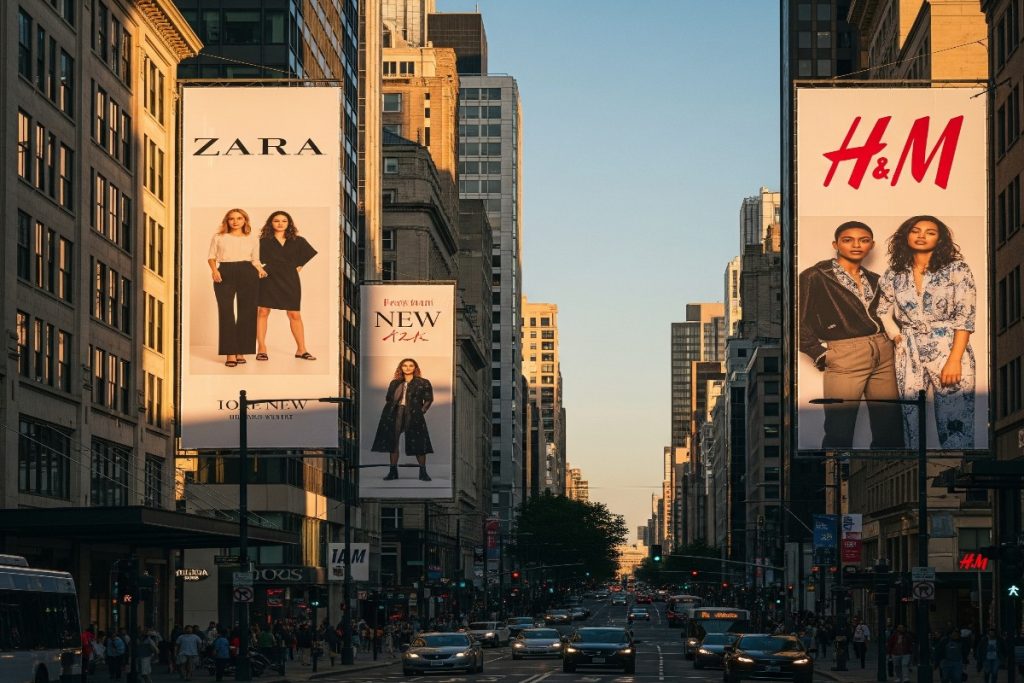Introduction
The competition between H&M and Zara represents one of the most intriguing conflicts within the global fashion sector. Both companies have excelled in the realm of fast fashion, yet they adopt markedly different strategies. H&M focuses on affordability and broad market appeal, whereas Zara capitalizes on rapid production, responsiveness to trends, and a sense of exclusivity. As of 2025, this rivalry has escalated to unprecedented levels, transforming the phrase “H&M vs. Zara” into a topic of interest not only for consumers but also for industry experts.
The Birth of Two Fashion Empires
H&M (Hennes & Mauritz) was established in Sweden in 1947, aiming to provide affordable fashion to the general public. Over the years, it grew internationally, providing inexpensive fashions for men, women, and kids.
Zara, conversely, was established in Spain in 1974 as part of the Inditex Group. It transformed fashion retail with its “fast fashion” method creating, manufacturing, and delivering new styles to stores in only a few weeks.
Each company followed distinct routes to achieve global fame, yet their success narratives emphasize how consumer desire for fashionable, reasonably priced apparel transformed the retail environment.
H&M’s Approach to Style and Pricing
H&M’s main principle focuses on providing fashionable, high-quality apparel at prices that are reachable for a wide range of consumers.
- Budget-friendly pricing – Targeting mid-market customers while maintaining a wide range of options.
- Wide assortment available – Fundamentals, seasonal styles, formal attire, and also designer partnerships.
- Wide appeal – Aims to engage a broad audience, spanning from teens to employed adults.
H&M partners with luxury designers such as Karl Lagerfeld, Balmain, and Moschino, enabling regular shoppers to experience high fashion at an affordable price.

Zara’s Speed-Driven Fashion Model
Zara’s primary competitive advantage is its rapid speed-to-market.
- Trend responsiveness – Zara is capable of transforming a design from concept to retail shelves in just 2–3 weeks.
- Limited stock strategy – This approach generates a sense of urgency and exclusivity, prompting customers to make immediate purchases.
- Limited advertising – Zara relies on carefully chosen store locations and customer referrals instead of significant marketing investments.
This strategy ensures that Zara’s collections remain current, giving customers the impression that they are consistently acquiring the latest runway-inspired styles. This is a key factor in the ongoing debate among fashion enthusiasts regarding whether to choose H&M or Zara for their shopping needs.
Marketing Moves That Set Them Apart
While Zara relies on store placement and trend-driven products to market itself, H&M takes a more traditional and media-driven approach.
- H&M – Runs large-scale ad campaigns, influencer collaborations, and seasonal promotions.
- Zara – Focuses on creating a premium shopping experience, both online and in-store, with minimal advertising but high turnover of new designs.
Both strategies work for their respective audiences: H&M connects through accessibility in the global fashion market, while Zara builds brand allure through scarcity.
The Sustainability Showdown
Sustainability has become a crucial element in the fashion sector, placing significant pressure on both brands to enhance their practices.
H&M – Makes substantial investments in sustainability efforts, such as the “Conscious Collection” and various garment recycling initiatives.
Zara – Pledges to utilize entirely sustainable materials by 2030 and to enhance transparency within its supply chain.
Nevertheless, critics contend that both brands continue to function within a fast fashion model, which fundamentally leads to overproduction and waste. Consumers who prioritize environmentally friendly practices often consider this aspect critically when deciding between H&M and Zara.
Global Reach and Customer Loyalty
H&M operates in over 70 countries with thousands of stores, making it one of the most widespread fashion retailers. Its affordable prices and frequent discounts keep customers returning.
Zara, while having fewer stores, maintains a strong global fashion presence in prime city locations. Its loyal customer base is drawn to the constant influx of new designs and the perception of exclusivity.
Digital presence is strong for both brands, with online shopping, mobile apps, localized platforms, and Instagram engagement worldwide.
Final Verdict: Who’s Leading the Race?
Ultimately, the debate between “H&M and Zara” is not centered on which brand is definitively superior; rather, it focuses on which brand better reflects your individual style, financial considerations, and shopping preferences.
H&M excels in providing a wide variety of styles at affordable prices, making it a preferred choice for everyday attire, seasonal essentials, and the opportunity to explore trends without excessive spending. Conversely, Zara establishes itself as a dynamic fashion leader, rapidly transforming runway designs into practical garments, offering consumers a sense of exclusivity and contemporary styling.
This competition drives both brands to enhance their offerings H&M prioritizes sustainable materials and eco-friendly collections, while Zara refines its supply chain to enable almost immediate trend releases. Ultimately, the true beneficiary is often the consumer, who gains access to a broader selection, competitive pricing, and a growing emphasis on environmentally responsible fashion without compromising on style.
Conclusion
The ongoing competition between H&M and Zara is far from concluded, and the year 2025 is set to bring further advancements in pricing, design, and sustainability. For consumers, this rivalry translates to increased options, enhanced quality, and new styles at every corner.
As this fashion competition unfolds on a global scale, opportunities within the retail sector encompassing designers and marketers are growing in the digital realm. Wiraa, a prominent remote job platform, assists professionals around the globe in securing flexible employment in fields such as fashion, marketing, and e-commerce, allowing talent to flourish without the constraints of location.




